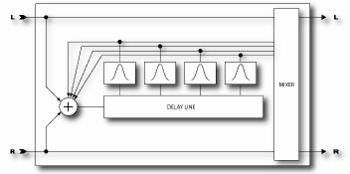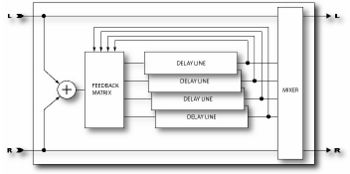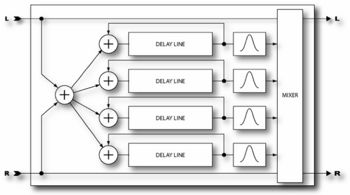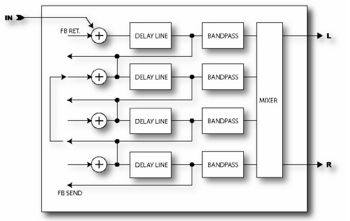Multi-delay
The Multi-Delay is a rhythmic delay block with eight sub-algorithms: Quadtap delay, Plex Delay, Plex Detune, Plex Shift, Band Delay, Quad-Series, Ten-Tap and Rhythm Tap. Delay times can be controlled by tempo allowing for rhythmic patterns to be easily created. All delay lines can be modulated by up to four LFO’s.
The standard algorithms allow for two seconds of delay in each of their four taps. The Ultra's ten-tap delay gives ten seconds of memory divided by the number of taps chosen. The rhythm tap delay allows a range of ten seconds of delay in each of its taps.
Contents
Parameters
Standard Parameters
- MASTER TIME - Scales all the delay times. Attach a controller to this for real-time control of the delay times.
- MASTER LEVEL - Scales all the output levels. Attach a controller to this for real-time control of the echo levels.
- MASTER PAN - Scales all the pan amounts essentially acting as a spread control. The amount can go negative allowing for the echoes to switch sides. Attach a controller to this for real-time control of the pans.
- MASTER FEEDBACK - Scales all the feedback amounts. You can attach a controller to this.
- MASTER FREQ - Scales all the frequency values. Attach a controller to this to vary all the frequency values in real-time. This can be used to achieve a wah-like effect on the echoes.
- MASTER Q - Scales all the Q values. Attach a controller to this to vary all the Q values in real-time.
- MASTER DETUNE - Scales all the detune values. Attach a controller to this to scale all the detune values in real-time. By varying the detune values this way, resonances are broken up and the delay becomes smoother.
- MASTER PITCH - Scales all the shift values. Attach a controller to this to vary all the pitch shifts in real-time.
- DECAY TIME - Sets the coefficients of the feedback matrix for the Plex types thereby controlling the amount of time for the echoes to fade. Use caution with the Detune and Shift types as high decay times can result in instability.
- DIFFUSION - Sets the amount of cross-coupling between delay lines.
- TIME - Sets the delay time of the tap.
- TEMPO - Locks the delay time to the global tempo. For example, if the global tempo is 120 bpm and the tempo is set to a quarter note (1/4) then the time will be 500 ms (one echo per beat). To ignore the global tempo set the tempo control to NONE.
- LEVEL - Sets the volume level of the tap.
- FEEDBACK - Sets the amount of delay feedback. This controls how many repeats are heard. The total of all feedbacks must add up to 100% or less.
- PAN - Controls the placement of the echoes in the stereo image. Note that this is different than the PAN control on the MIX page which controls the panning of the mixed sound. This control only effects the wet signal.
- DETUNE - Sets the amount of pitch detune for the delay line for the Plex Detune and Plex Shift types.
- SPLICE LEN - Sets the splice time for the detuners. Longer times are smoother but less precise.
- DIRECTION - Sets direction of the pitch shifter. Reverse can be used for atmospheric textures.
- CROSSFADE - Sets the amount of overlap in the audio snippets. A low setting will make the echoes
more discrete whereas a high setting will tend to smear the echoes.
- SHIFT - Sets the amount of pitch shift for the delay line for the Plex Shift type.
- FREQ - Sets the center frequency of the delay line output filter.
- Q - Sets the ‘Q’ of the delay line output filter. Higher values result in narrower bandwidth. The Axe-Fx uses a constant power algorithm so higher Q’s increase the gain of the filter. As such, use caution as overloads could result with some program material.
- LFO RATE - Controls the frequency of the Low Frequency Oscillator (LFO). Use low settings with higher depths for slow moving sounds. Increase the rate for vibrato effects. Set fully CCW to sync the LFO to the Global LFO1 oscillator.
- LFO TEMPO - Locks the rate to the global tempo. For example, if the global tempo is 120 bpm and the tempo is set to a quarter note (1/4) then the LFO rate will be 2 Hz (120 bpm / 60 seconds = 2). To ignore the global tempo set the tempo control to NONE.
- LFO DEPTH - Sets the maximum delay variation. Higher depths increase the amount of detuning. Usually the rate and depth settings should be varied inversely, i.e. if you increase the rate decrease the depth however some unique sounds can be obtained using high rates and depths.
- FDBK SEND - Sets the feedback send tap for the Quad-Series type.
- FDBK RET - Sets the feedback return tap for the Quad-Series type.
- Important Note - firmware version 5 and beyond significantly changed the Plex-Shift algorithm to get pre-5.X patches to sound as intended do the following:
1. Set crossfade between 50-100%.
2. Set times to half original value.
Ten Tap Delay
The Ten Tap Delay is a special kind of delay that allows you to precisely control the repeats. It is implemented essentially as 10 delays in series. You can control the exact number of repeats, up to 10, along with the decay, level and panning.
- MONO/STEREO - Sets the mode of the Ten-Tap Delay. In mono mode twice as much delay per tap is possible.
- DELAY TIME - Sets the delay time per tap.
- DELAY TEMPO - Sets the delay tempo per tap. This overrides the delay time paramter.
- NUMBER OF TAPS - Sets the exact number of repeats.
- DECAY - Sets how rapidly the repeats decay. A value of zero will have no decay and all repeats will be at the same volume.
- SHUFFLE - Sets the amount of time offset for the odd taps to give a shuffle feel to the repeats.
- SPREAD - In stereo mode sets the spread of the repeats. At maximum the left channel is panned full left and the right channel full right.
- RATIO - Sets the ratio of the left delay time to the right in stereo mode.
- PAN SHAPE - Controls the shape of the panning as a function of tap number. The repeats can slowly move from one side to the other (inreasing / decreasing) stay constant, or move back and forth (sine).
- PAN ALPHA - Controls how quickly the repeats move as a function of tap number and pan shape. Higher values produce a more pronounced effect. To alternate left-right set the PAN SHAPE to SINE and the PAN ALPHA to maximum.
- LOW CUT - Sets the cutoff point of the highpass filter. Higher values reduce the amount of low frequencies per repeat.
- HIGH CUT - Sets the cutoff point of the lowpass filter. Higher values reduce the amount of high frequencies per repeat.
- TAPn LEVEL - Sets the relative level of the repeat.
Rhythm Tap Delay
The Rhythm Tap Delay uses basically the same algorithm as the Ten Tap Delay but allows you to enter the exact rhythm of the repeats. You can enter the rhythm either manually or by tapping the rhythm in with the ENTER button. The parameters for the Rhythm Tap Delay include most of the Ten Tap Delay parameters listed above plus the following:
- FEEDBACK - Sets the feedback level from the last repeat to the input of the delay line. You can use this in conjunction with the decay to control the overall decay behavior. If you set decay to zero and feedback to a moderate value, the pattern will repeat getting quieter each time through.
- QUANTIZE - Quantizes the tap times to the entered note value. This can be used to aid in tapping in a rhythm. The tap times will be rounded to the nearest multiple of the note duration. You can change this value even after you’ve tapped in your rhythm.
- LEARN - Sets this to <TAP ENTER> to enter the rhythm pattern learn mode. You can then tap the desired rhythm in with the ENTER button. When finished set to <DONE>. If the ENTER button is not pressed after several seconds the unit will automatically terminate the learn mode.
Diffusor
The Diffusor is comprised of four two-second diffusers in series. A diffuser smears transients and can be used as a type of reverb for creating interesting ambience effects.
- MASTER TIME - Scales all the delay times. Attach a controller to this for real-time control of the
delay times.
- MASTER FEEDBACK - Scales all the feedback amounts. You can attach a controller to this.
- TIME n - Sets the delay time each diffuser.
- TEMPO n - Locks the time to the global tempo. For example, if the global tempo is 120 bpm and
the tempo is set to a quarter note (1/4) then the time will be 500 ms (one echo per beat). To ignore the global tempo set the tempo control to NONE.
- FEEDBACK n - Sets the feedback level for each diffuser. For maximum diffusion set to 100%.
Spillover
The Multi-delay block doesn't allow spillover. If you want spillover, use the regular delay block instead.
Tips
Set the type to Plex Detune. Set the times really low, i.e. 10, 18, 26, 34 ms and the detunes to, say, -7, +7, -14, +14. Set the decay time to minimum, crossfade to 50%. Now you have four detuners, which sounds nice and thick.



